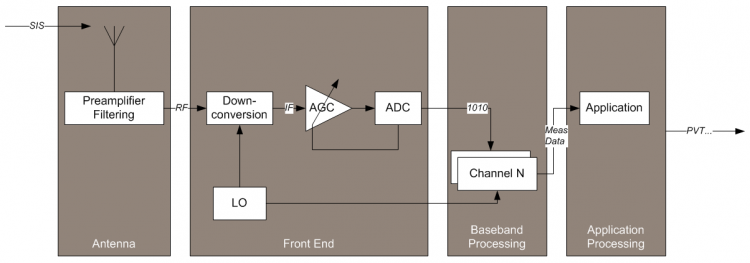If you wish to contribute or participate in the discussions about articles you are invited to contact the Editor
System Design Details
| Receivers | |
|---|---|
| Title | System Design Details |
| Author(s) | GMV |
| Level | Medium |
| Year of Publication | 2011 |
In order to process the L-band signals transmitted from the satellites and compute the navigation solution, a GNSS receiver can be designed to target different applications, markets, and solutions. From single or multi-frequency, single or multi-constellation, to survey or automotive applications, system specification details extend through a broad range of decisions and trade-offs, in order to achieve the best performance desired. The following sections tackle some considerations at a GNSS receiver system design level.
Overview
Most of the current GNSS receiver systems gather (at least) the blocks depicted in Figure 1, although some architecture variations might be present to accommodate different solutions. Besides these blocks, other common receiver components are the power unit (e.g. batteries) or the enclosure (e.g. for ruggedization). All such components and blocks are carefully chosen when a GNSS receiver is designed for a target application, and different considerations are made on the choices and trade-offs involved.
Furthermore, in order for a GNSS receiver to be able to provide the required solution, the specification team should have a clear knowledge of the system as a whole, with special focus on the space segment (satellites, RF signals, modulations and bandwidths) and user segment (hardware, receivers and applications). At system design level, it is the interface between these two segments that is targeted, and a receiver is tailored not only to provide PVT (or other) solutions, but also to take full advantage of the characteristics of the signals received and their respective transmitting satellite constellation(s).
Block diagram
The figure shows the main blocks inside a GNSS receiver system, as they represent most of the dimensioning and engineering work involved in a receiver system specification and design. These different subsets, from a functional point of view, can be categorized as antenna, front end, baseband processing and applications processing, and are shortly described as[1]:
- Antenna: L-band antenna for capturing GNSS signals, with the associated amplification and filtering. It represents the entry point from the space segment to the user segment.
- Front End: Hardware section for down-conversion, filtering / amplification, and sampling (digitizing) of captured analog signals. Converts the analog GNSS signals to digital data streams.
- Baseband processing: All acquisition and tracking signal processing tasks are performed in baseband processing blocks, where the core functions that enable GNSS signal tracking occur (correlations, lock loops, filters, etc).
- Applications Processing: Since the target application for a receiver can vary, the applications processing block is designed to extract the GNSS measurements, observables, and navigation data, and compute the desired solutions - for instance, the position of the user on Earth.
Design considerations
| Technology | Development Costs | Performance | Power Consumption | Single Unit Costs | Flexibility |
|---|---|---|---|---|---|
| ASIC |
Related articles
- Generic Receiver Description
- Receiver Types
- Antennas
- Front End
- Baseband Processing
- Applications Processing
References
- ^ For further details, reffer to their corresponding articles (links provided in the "Related Articles" section).

